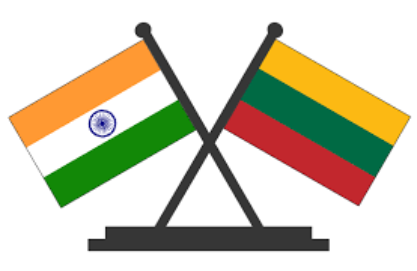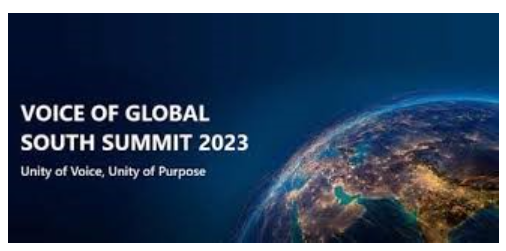Wednesday, 29th November 2023
Patriarchy in Indian Judiciary
In News: The presence of women in the higher echelons of the Indian judiciary is restricted, prompting concerns regarding gender equality within the legal system.
Women in the Indian Judiciary: A Status Overview
- Supreme Court Representation
- Since 1989, a mere 10 women have been appointed to the Supreme Court, and presently, out of 33 judges, only three are women.
- High Courts Representation
- None of the 25 High Courts, except Gujarat High Court, currently has a female Chief Justice. Among 782 working high court judges, only 107, or 13%, are women.
- Lower Judiciary Representation
- A 2018 study reveals that women's representation, at 27% in the lower judiciary, significantly decreases in higher appointments.
- The India Justice Report 2022 notes that only 13% of High Court judges and 35% of Subordinate Court judges are women.
Factors responsible for lower representation of women in Indian judiciary
- Factors contributing to the underrepresentation of women in the judiciary include deeply rooted patriarchal norms in society, a higher influx of women into the lower judiciary, but a lack of transparency in the Collegium system hindering their progression to higher positions.
- Despite existing reservation policies for women in the lower judiciary in several states, there is a notable absence of such provisions for the higher judiciary.
- The scarcity of women advocates further diminishes the available talent pool for selecting women judges.
- Additionally, inadequate judicial infrastructure, such as the absence of women's washrooms, serves as an additional impediment to women in the legal profession.
Advantages of Augmented Women Participation:
- Enhanced inclusivity and improved representation of a substantial yet marginalized segment of society.
- A judiciary characterized by gender diversity signifies an impartial legal system.
- The inclusion of women judges communicates a commitment to a judiciary that is open and accessible.
- It fosters a more approachable atmosphere for women seeking recourse through the legal system.
- Encourages an empathetic approach, particularly in addressing crimes against women.
- A varied bench introduces a range of experiences and perspectives.
- The presence of women judges serves as an inspiration for younger women to pursue careers within the legal and judicial domains.
Impacts of Insufficient Women Representation in the Judiciary:
- Biased Judicial Decisions: The absence of a gender perspective contributes to prejudiced judgments.
- For instance, in August 2020, the High Court of Madhya Pradesh granted bail to a molester with the unusual condition that he would tie a Rakhi to the victim.
- Shortcomings in Legal Reasoning: Inadequate representation hinders the legal system's comprehension of diverse social contexts.
- An example is a June 2020 case where the Karnataka High Court, while granting bail to a rape accused, made observations about the victim's post-incident behaviour, suggesting an unrealistic expectation of how a rape victim should ideally behave.
- Erosion of Trust: Low representation raises concerns about the credibility of courts as true representatives of society.
Subject: Advancing Women's Representation in the Judiciary: A Call to Action
- Policy Advocacy
- Lobby for the implementation of affirmative action policies, including reservation quotas for women, in both the lower and higher judiciary.
- This will create a more level playing field for women seeking judicial appointments.
- Transparency and Accountability
- Advocate for increased transparency in the judicial appointment process, particularly within the Collegium system.
- This can help address biases and ensure that the selection of judges is based on merit and diversity.
- Mentorship Programs
- Establish mentorship programs to support aspiring women advocates, providing guidance, networking opportunities, and insights into navigating the legal profession.
- Mentorship can significantly contribute to the professional growth of women in law.
- Educational Initiatives
- Implement outreach programs to encourage young girls and women to pursue legal education.
- By fostering an early interest in the legal field, we can cultivate a diverse pool of talent for future judicial appointments.
- Infrastructure Improvements
- Advocate for improved judicial infrastructure, including facilities such as women's washrooms.
- Creating a conducive and inclusive environment is crucial for attracting and retaining women in the legal profession.
- Awareness Campaigns
- Launch public awareness campaigns to highlight the importance of gender diversity in the judiciary.
- Promoting a more inclusive narrative can garner public support and encourage stakeholders to prioritize gender-balanced appointments.
- Training Programs on Gender Sensitivity
- Introduce mandatory training programs for judges and legal professionals to enhance their understanding of gender issues and promote sensitivity in judicial proceedings.
- This can contribute to fair and impartial judgments.
- Collaborative Partnerships
- Foster collaborations between legal institutions, non-governmental organizations, and advocacy groups to collectively address barriers to women's representation in the judiciary.
- A collaborative approach can amplify the impact of initiatives.
Source: IE
India-APEC Relations - Edukemy Current Affairs
In News: The 2023 APEC summit in San Francisco marked a pivotal moment as the U.S. and China resumed communication after nearly a year.
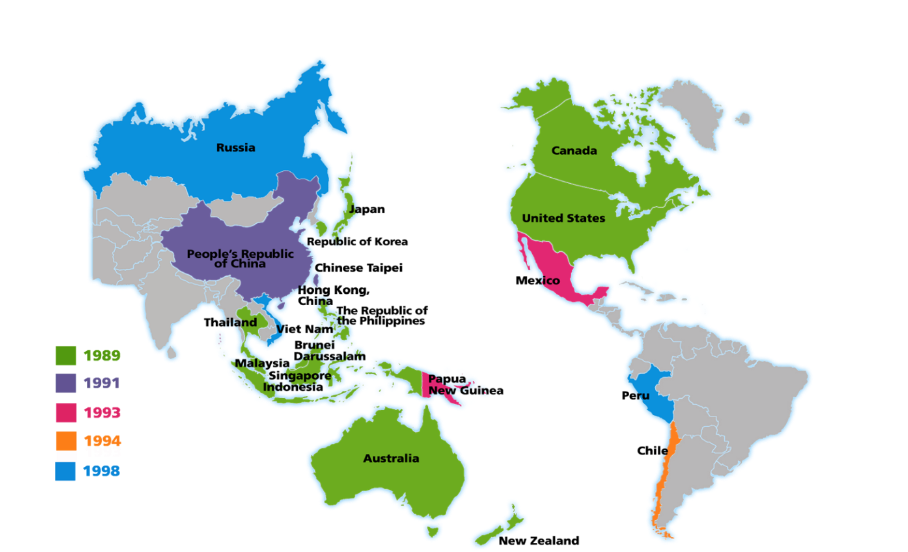
APEC 2023 Summit Highlights
Theme: "Fostering Resilience and Sustainability for All"**
Key Agreements
- Golden Gate Declaration
- Focus on building resilience and sustainability across member economies.
- Goals include a functional WTO dispute settlement system by 2024 and pursuit of a Free Trade Area of the Asia-Pacific.
- APEC Action Agenda on Climate Change and Energy Security
- Endorsement of specific actions and targets to address the climate crisis and ensure energy security through enhanced cooperation.
- Strategic Emphasis
- The U.S. underscored a strategy of de-risking and diversifying from China, rather than complete decoupling.
- Regional Trade Dynamics
- Taiwan's pursuit of entry into the Comprehensive and Progressive Agreement for Trans-Pacific Partnership (CPTPP).
Asia-Pacific Economic Cooperation (APEC): Fostering Prosperity and Cooperation
- Established in 1989, the Asia-Pacific Economic Cooperation (APEC) serves as a pivotal regional economic forum, strategically navigating the growing interdependence of the Asia-Pacific.
- Mission
- APEC is dedicated to fostering greater prosperity for the region's inhabitants by championing balanced, inclusive, sustainable, innovative, and secure growth.
- It actively accelerates regional economic integration to ensure shared benefits.
- Key Functions
- APEC's initiatives extend beyond traditional economic realms.
- The forum works to empower all Asia-Pacific residents by offering digital skills training to rural communities and facilitating the export endeavours of indigenous women.
- In response to the challenges of climate change, APEC members implement measures to enhance energy efficiency and advocate for the sustainable management of forest and marine resources.
- The forum continually adapts to address emerging challenges such as disaster resilience, pandemic planning, and counter-terrorism efforts.
- Membership
- Comprising 21 member economies, APEC boasts a diverse and influential roster, including Australia, China, Japan, the United States, and others.
- Encompassing nearly 3 billion people and contributing to about 60% of the world's GDP, these member economies span the Pacific Rim, creating a dynamic collaboration from Chile to Russia, Thailand to Australia.
- Significance
- APEC stands as a powerful force in shaping the economic landscape, emphasizing cooperation and collective well-being.
- With its extensive membership and broad-reaching initiatives, APEC plays a crucial role in propelling the Asia-Pacific region towards a future characterized by prosperity, innovation, and sustainable development.
Challenges in India-APEC Relations
- APEC's Membership Moratorium
- India's interest in joining APEC has been hindered by APEC's moratorium on new members since 1997.
- Trade Liberalization Concerns
- Some APEC members perceive India as not fully endorsing trade liberalization and regional integration, as evidenced by India's non-participation in initiatives like RCEP.
- Bilateral Investment Treaties
- Apprehensions arise from India's reluctance to engage in comprehensive bilateral investment treaties, impeding seamless economic collaboration within the APEC framework.
- Pace of Domestic Reforms
- India faces scrutiny for the perceived sluggishness in implementing domestic economic reforms, particularly concerning FTAs and taxation policies.
- Domestic Resistance
- Protectionist forces within India, spanning business, political, and bureaucratic sectors, pose challenges by resisting further international trade openness, adding complexity to APEC negotiations.
|
UPSC Previous Year Questions Prelims (2015) Q. India is a member of which among the following?
Select the correct answer using the code given below: (a) 1 and 2 only (b) 3 only (c) 1, 2 and 3 (d) India is a member of none of them Ans: B Prelims (2009) Consider the following pairs
Which of the above pairs is/are correctly matched? (a) 1 and 2 only (b) 2 only (c) 2 and 3 only (d) 3 only Ans: B |
Source: IE
Vibrant Kolkali: Kerala's Cultural Tribute
In News: Kolkali is presented by the mothers' association of the Thrissur Archdiocese as a tribute to the arrival of St. Thomas in India.
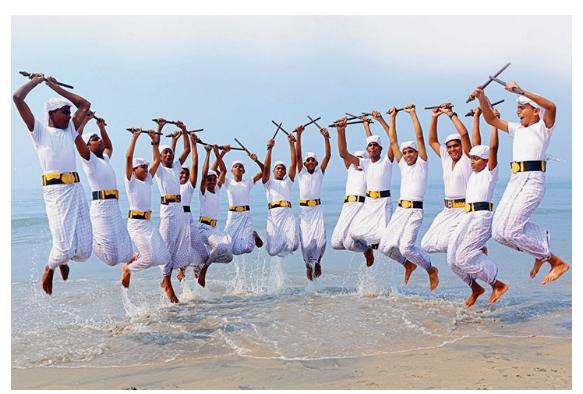
About Kolkali
- Kolkali is a traditional folk-dance form that originates from the Indian state of Kerala.
- It is often performed in a group, with participants wielding sticks and moving rhythmically in a circle, striking the sticks of the adjacent dancers in a coordinated manner.
- The dance is known for its vibrant and energetic movements, accompanied by rhythmic beats.
- Typically performed during festivals and cultural events, Kolkali has deep cultural roots in Kerala and is a celebration of unity and camaraderie.
- The dance form has both religious and social significance, often being performed during temple festivals and other auspicious occasions.
- The performers, usually arranged in a circular formation, move in a synchronized manner, creating a captivating visual spectacle.
- The rhythmic tapping of the sticks and the agile footwork add a dynamic element to the performance.
- The dance is not only a display of skill but also a reflection of the rich cultural heritage of Kerala.
- Kolkali is not confined to any specific age group, and both men and women participate in its vibrant performances.
- The dance serves as a platform for communities to come together, celebrate, and pass on their cultural traditions to the next generations.
- Overall, Kolkali embodies the spirit of joy, teamwork, and cultural pride in the vibrant tapestry of Kerala's traditions.
Madiga community - Edukemy Current Affairs
In News: Prime Minister has taken the initiative to establish a committee to address the longstanding request for the sub-categorization of the Madiga community within the Scheduled Castes.
Why the need?
- The Madiga community, representing approximately 50% of Telangana's Scheduled Caste (SC) population, has persistently called for a more balanced allocation of reservation benefits.
- They argue that the current distribution has disproportionately favoured the Mala community.
- This initiative seeks to rectify historical disparities by promoting an equitable distribution of reservation benefits among all sub-castes within the SC category.
About The Madiga community
- The Madiga community, a Telugu caste, predominantly resides in the states of Andhra Pradesh, Telangana, and Karnataka, with a smaller minority presence in Tamil Nadu.
- Historically, Madigas have been associated with occupations such as tannery, leatherwork, and small handicrafts.
- Over time, many members of the Madiga community have transitioned to become agricultural laborers, reflecting changes in their economic activities.
Source: TH
Taiwan - Edukemy Current Affairs
In News: Taiwan and India are in discussions regarding the potential recruitment of tens of thousands of Indian workers through agreements on employment mobility.
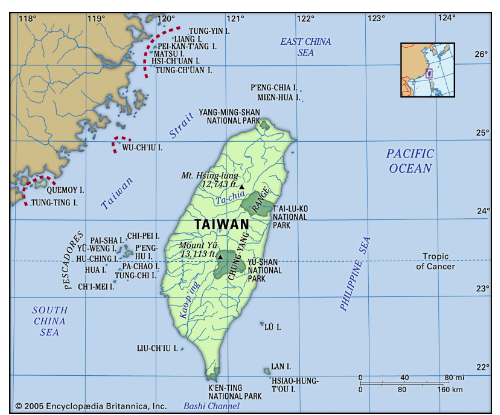
About Agreement
The agreement aims to address Taiwan's labour shortages by sending Indian workers to sectors like manufacturing and agriculture, responding to the challenges posed by Taiwan's aging population.
Similar agreements have been established with other countries, including:
- India and Germany's 'Comprehensive Migration and Mobility Partnership' to facilitate mobility and employment opportunities between the two nations.
- Migration, Mobility Pact with Australia (MMPA) between India and Australia.
Notably, Taiwan recently announced the opening of its third representative office in Mumbai, India. Despite the absence of formal diplomatic relations, India and Taiwan have seen progress in areas such as economics, trade, and technology.
About Taiwan
- Taiwan, officially the Republic of China, is situated in East Asia, bordered by the East and South China Seas.
- It shares borders with the People's Republic of China, Japan, and the Philippines.
Source: IE
Nugu Wildlife Sanctuary - Edukemy Current Affairs
In News: The National Tiger Conservation Authority (NTCA) is proposing the designation of the Nugu Wildlife Sanctuary, adjacent to the Bandipur Tiger Reserve, as a core critical tiger habitat.
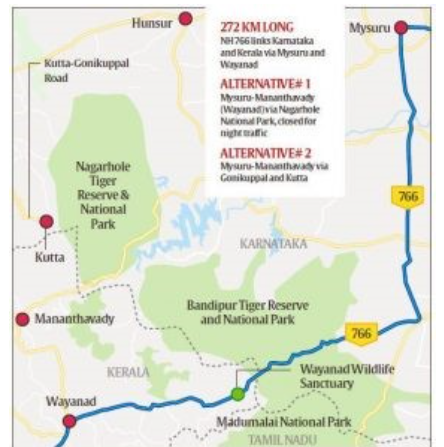
About Nugu Wildlife Sanctuary
- Nugu Wildlife Sanctuary is situated north of Bandipur National Park in Mysore District of Karnataka, India.
- The northern part of the sanctuary is occupied by the Nugu reservoir.
- It has been declared as an eco-sensitive zone by the Ministry of Environment, Forest and Climate Change.
- It has been marked as a vulnerable region in terms of man-animal conflict.
- It serves as a home to many species of flora and fauna such as Dipterocarpus indicus, Calophyllum tomentosum, elephants, wild pigs etc
|
UPSC Previous Year Questions Prelims (2012) Q. Consider the following protected areas:
Which of the above are declared Tiger Reserves? (a) 1 and 2 only Ans: B Prelims (2017) Q2. From the ecological point of view, which one of the following assumes importance in being a good link between the Eastern Ghats and the Western Ghats? (a) Sathyamangalam Tiger Reserve Ans: A |
Source: TH
New Generic Drugs Treat Four Rare Diseases
In News: India's Health Ministry introduces generic drugs for treating Tyrosinemia-Type 1, Gaucher’s Disease, Wilson’s Disease, and Dravet-Lennox Gastaut Syndrome.
Understanding Generic Drugs
- Generic drugs are counterparts to brand-name medications, sharing identical active ingredients, dosage, safety, strength, quality, and intended use.
- They offer a more affordable alternative once the patent protection for a brand-name drug expires.
Significance of Generic Drugs for Rare Diseases
Unbranded generic drugs for Tyrosinemia-Type 1, Gaucher’s Disease, Wilson’s Disease, and Dravet-Lennox Gastaut Syndrome bring a substantial cost reduction—approximately 100 times less than the market value of branded drugs.
Understanding Rare Diseases
- Rare diseases, as per WHO, are chronic conditions with a prevalence of 1 or less per 1000 population.
- In India, they impact around 6-8% of the population, translating to approximately 8 to 10 crore cases, with a significant 80% being of genetic origin.
National Policy for Rare Diseases (NPRD), 2021
- The NPRD, 2021, offers substantial support, including financial assistance up to Rs. 50 lakhs for treatment, exemption of Rare Diseases drugs from Basic Customs Duty, and the inclusion of orphan drugs in the Production Linked Incentive Scheme for Pharmaceuticals.
Source: TH
Casgevy - Edukemy Current Affairs
In News: The UK drug regulator has granted approval to Casgevy, a gene therapy designed for sickle cell disease and thalassaemia.
Casgevy: Pioneering Gene-Editing Therapy for Sickle Cell Anaemia
- Casgevy stands as a revolutionary gene-editing therapy specifically designed for sickle cell anaemia, harnessing the power of the CRISPR-Cas9 tool.
- This groundbreaking treatment aims to rectify the flawed gene responsible for blood disorders, presenting a potential lifelong cure.
- The therapy strategically targets the BCL11A gene to enhance the production of foetal haemoglobin, ultimately reducing the frequency of severe pain crises and the necessity for blood transfusions.
Challenges in Casgevy's Implementation
- While Casgevy holds immense promise, challenges lie ahead, including the potential high cost, estimated to reach up to $2 million per patient.
- Additionally, there is a pressing need for the enhancement of local manufacturing facilities to ensure wider accessibility to this transformative therapy on a global scale.
Source: IE
International Sugar Organisation (ISO)
In News: India has been appointed as the Chair of the International Sugar Organisation (ISO) for the year 2024, as declared during the 63rd council meeting conducted in London.
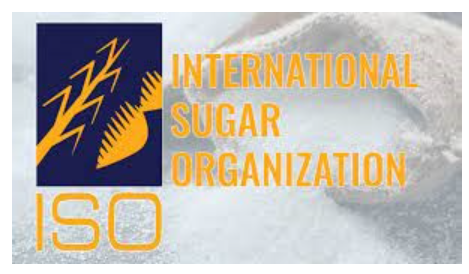
About International Sugar Organisation (ISO
- ISO, short for the International Sugar Organization, is an intergovernmental organization headquartered in London, founded in 1968.
- It operates under the International Sugar Agreement of 1968, tasked with administering the agreement to establish a balanced relationship between global sugar supply and demand in the world market.
- Currently, it boasts 88 member countries, with Saudi Arabia joining in 2022.
Source: PIB
NASA’s Psyche spacecraft - Edukemy Current Affairs
In News: NASA's Psyche spacecraft, en route to a metal-rich asteroid, is pioneering Deep Space Optical Communications (DSOC) with near-infrared laser signals for high-bandwidth communication.
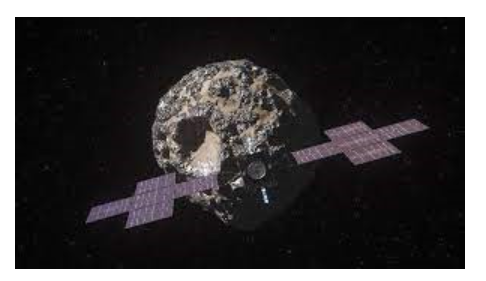
Deep Space Optical Communication (DSOC)
- Deep Space Optical Communication (DSOC) is an innovative space communication technology that employs near-infrared laser signals in contrast to the conventional use of radio waves.
- Unlike radio waves, DSOC offers superior bandwidth capabilities, enabling data rates that are at least 10 times faster than those achievable with current radio systems.
Functioning
- DSOC operates by encoding data in photons at near-infrared wavelengths, deviating from the traditional use of radio waves for communication between a deep space probe and Earth.
- The utilization of light instead of radio facilitates the transmission of more data within a given timeframe.
- Accurate pointing in DSOC is achieved through the application of near-infrared lasers, ensuring precision despite spacecraft vibrations.
- Adaptive systems compensate for changing positions, marking DSOC as a groundbreaking approach in deep space missions.
Significance
- The advancement in DSOC is pivotal for long-distance spacecraft communication, especially in endeavours like human exploration of Mars.
- Its benefits include the capability for higher resolution images, elevated data transfer rates, and the potential for streaming video, enhancing the overall effectiveness of deep space missions.
Source: IE
Same-sex couples: A judge to the rescue
In News: Following the disappointing Supreme Court ruling, Judge Anand Venkatesh brings optimism for LGBTQIA+ couples.
Challenges Encountered by the LGBTIQ+ Community
- Heteronormativity
- Inequality and Violence
- Deprivation of Rights
- Social Isolation
- Family Conflict
- Racial Discrimination
Sushma vs Commissioner of Police
- This case advocates for the incorporation of rights and protections for the LGBTIQ+ community, addressing issues related to harassment, violence, and discrimination in areas such as employment, housing, and societal integration.
- The State government is mandated to implement these measures.
Supriyo Judgment
- No inherent right to marriage is recognized as a fundamental right.
- Discrepancies exist between majority and minority opinions regarding the recognition of civil unions.
- The minority viewpoint supports acknowledging a range of entitlements.
- However, the judgment falls short of providing explicit rights and precise directives.
- The majority opinion leaves the fate of same-sex couples to the discretion of the government and legislature.
- The Supreme Court has emphasized that statutory laws, including the Constitution and marriage laws, cannot be invoked in this matter.
Concerns with the Judgment
- Doctrine of Indirect Discrimination:
- The judgment raises issues with the doctrine of indirect discrimination, emphasizing that the discriminator cannot evade constitutional obligations by citing intent or object.
- Impact Assessment Requirement
- The court is urged to consider the impact of a law on a specific group, as emphasized in Nitisha v. Union of India, 2021, challenging the notion that the mere absence of a law is enough to claim discrimination.
- Failure to Address Discrimination Based on Sexual Orientation
- The State's decision to deny recognition to a specific category of marriages solely based on sexual orientation is not explicitly confronted by the Bench.
- Lack of Resolution on Institutional Limitations
- The judgment does not effectively address the issue of whether the court can strike down the constitutional validity of the Special Marriage Act (SMA) or introduce modifications due to its institutional constraints.
- Reluctance to Challenge Unconstitutional Laws
- The court's stance suggests that even if a law is blatantly unconstitutional, the difficulties in providing a remedy are deemed sufficient reason to retain the unconstitutional law.
Recommended Actions
- Avoiding Constitutional Scrutiny in Legislation
- Parliament can craft laws in a manner that necessitates the court to engage in intricate interpretation, potentially sidestepping direct constitutional scrutiny.
- Recognizing Equal Rights Beyond Policy
- Conceiving the issue of equal rights in marriage solely as a policy matter is problematic and should be expanded beyond this narrow perspective.
- Establishing a Registration Procedure
- Implementing a registration process for contracts related to same-sex unions would allow the State to endorse relationships within the community, providing societal recognition and protection.
- Institution of Civil Unions
- The State government has the authority to enact legislation introducing the institution of Civil Unions, thereby conferring a formal status on same-sex couples.
- This can encompass various aspects, including marriage, divorce, inheritance, succession, minors, and adoption.
- Utilizing Legislative Powers
- Given that laws pertaining to marriage, divorce, and related matters fall under the Concurrent List in the Seventh Schedule of the Constitution, states possess the authority to legislate on these subjects.
- This grants the State the power to enact comprehensive legislation addressing the needs of same-sex couples.
Source: TH
Share the article
Edukemy’s Current Affairs Quiz is published with multiple choice questions for UPSC exams
MCQ
Get Latest Updates on Offers, Event dates, and free Mentorship sessions.

Get in touch with our Expert Academic Counsellors 👋
FAQs
UPSC Daily Current Affairs focuses on learning current events on a daily basis. An aspirant needs to study regular and updated information about current events, news, and relevant topics that are important for UPSC aspirants. It covers national and international affairs, government policies, socio-economic issues, science and technology advancements, and more.
UPSC Daily Current Affairs provides aspirants with a concise and comprehensive overview of the latest happenings and developments across various fields. It helps aspirants stay updated with current affairs and provides them with valuable insights and analysis, which are essential for answering questions in the UPSC examinations. It enhances their knowledge, analytical skills, and ability to connect current affairs with the UPSC syllabus.
UPSC Daily Current Affairs covers a wide range of topics, including politics, economics, science and technology, environment, social issues, governance, international relations, and more. It offers news summaries, in-depth analyses, editorials, opinion pieces, and relevant study materials. It also provides practice questions and quizzes to help aspirants test their understanding of current affairs.
Edukemy's UPSC Daily Current Affairs can be accessed through:
- UPSC Daily Current Affairs can be accessed through Current Affairs tab at the top of the Main Page of Edukemy.
- Edukemy Mobile app: The Daily Current Affairs can also be access through Edukemy Mobile App.
- Social media: Follow Edukemy’s official social media accounts or pages that provide UPSC Daily Current Affairs updates, including Facebook, Twitter, or Telegram channels.

